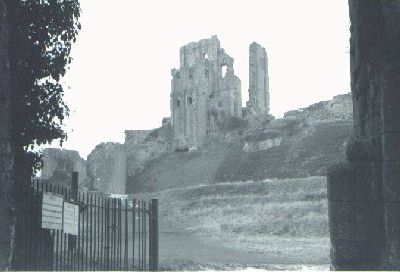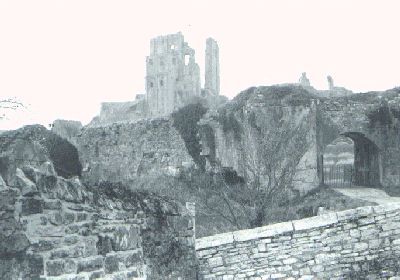|
|
|


Introduction The SiteThe Isle of Purbeck (not really an island) is a peninsula in southern Dorset, bounded on the north and east by Poole Harbour, to the south by the English Channel and to the west by the rivers Piddle and Frome, where the access to the area is controlled by the ancient Saxon burgh of Wareham, one of Alfred the Great's strongholds against the Danes. Swanage, also an ancient place, which is more of a yacht haven than anything else now, protects the SE side of the island. The quarries of Purbeck have been famous for centuries, St Paul's cathedral and Westminster Bridge, along with a lot of Norman/Plantagenet buildings, having been constructed of this very fine limestone. In the middle of this 'island' is a very large hill, overlooking all access to the peninsula, undoubtedly even used as a fortress in the Iron Age although no remains have been found or looked for. On this site was built the most magnificent castle of the Middle Ages in England -- yes, the Tower of London, Windsor, and some others might be more impressive now, but Corfe really comes the closest to what one might imagine the legendary Camelot to look like, even in its current state of dignified ruin. It was the site also of the last great siege of a medieval castle against the cannons and infantry of a modern army (Cromwell's). Its subsequent destruction* was done very vindictively and thoroughly by a parliamentary committee. But the destruction was not complete, the structure was too strong, and what remains is still one of the most impressive castle ruins in England. There is currently a very nice village huddled underneath the castle. It looks old, with undulating stone roofs and nice pubs, etc. It is a fine place for tourists and has been trendied up for that purpose, yet it is not in its current incarnation that old, for the Parliamentary troops totally destroyed it during the siege of the castle. No doubt a lot of its existing stonework was looted from the castle ruins, as the original village is more likely to have been built of wood and wattle-and-daub. Early History

SaxonsThe hill on which the castle is located is isolated, but stands on a ridge that cuts Purbeck in half, so that access from the mainland has to pass under its walls and thus it commanded the whole island and at one time the castle was the most formidable fortress in England. After King Alfred, who defeated the Danish fleet off Swanage (actually, that was destroyed by a storm), King Edgar made it his principal residence. Edgar's widow Elfrida (she was Edgar's second wife) was one of those Morgan-la-Fay characters and arranged the murder of her stepson Edward the Martyr, the legal king, in favor of her own son Ethelred. It's a good story -- he got stabbed in the back by one of her servants while he was drinking wine, Edward fled the building badly wounded, but fell off his horse from faintness, and was dragged, with his foot caught in a stirrup, over a gravel river bed and got ripped to pieces. Elfrida recovered the body and hid it, but didn't get away with this crime (the monks who found the body buried it in Wareham and declared him a saint -- who knows why, but if you want to celebrate his martyrdom for any reason, it is March 18); however, miraculous events were claimed and Elfrida went to a nunnery in shame. Her son Ethelred who became king is the famous "Unready" meaning ill-advised, not unprepared. He was a wimp and all of Dorset except for Corfe Castle fell to the Danes, then King Canute (Knut) took over after a few years of chaos. Somebody should do a historical novel about these events -- it's good stuff. NormansSince this was an important Saxon stronghold, the castle pre-dates the Norman Conquest and became William's property. Empress Maude held it against King Stephen and it withstood a siege in 1153. Later it became a favorite residence of King John, because it was inaccessible, and here he kept his State Prison where he starved to death 22 knights of France who supported the heir Prince Arthur of Brittany (whom John had murdered, we hear). He did a really stupid thing, by declaring war on France, summoned all his barons to meet him in Portsmouth, instead went to Corfe Castle, then fined them all for not accompanying him on his expedition. No wonder they instigated Magna Carta! John also judicially murdered Peter the Hermit who had the gall to predict events about John that came true, about being excommunicated then restored by Pope Innocent. Peter was hanged at Corfe. Middle AgesThe castle was built up to its present strength during the reign of Edward II -- i.e., the massive walls and towers, although the keep dated back a couple of hundred years. Queen Isabella and her lover Mortimer, having secretly murdered Edward at Berkeley Castle, later pulled a scam on Edmond, the Duke of Kent (Edward's brother), convincing him that his brother was still alive and imprisoned at Corfe, and getting him to try some incriminating rescue attempts and letters to the effect, which got him beheaded for treason at the age of 28. (God, aren't these marvellous villains?)
Edmond's daughter married the Black Prince and gave birth to the unfortunate Richard II. Corfe went through several ownerships then, who all came to unfortunate ends, such as the Duke of Clarence, who was drowned in the butt of malmsey. Under the Henry's it went into the Somerset family, who were also involved too much in politics for their survival in the long run. Elizabeth gave it to Sir Christopher Hatton, who mounted cannons as defense against the Spanish Armada. Hatton ended up as Lord Chancellor. A subsequent owner (Sir Edward Coke) had a rather unusual marriage for the time, to the Earl of Exeter's daughter, who was courted by Thomas Bacon but turned him down; the marriage was a scandal, even though Coke became the Chief Justice -- she refused to be called by his name or even live with him. He was eventually impeached for crimes that she basically committed (will fraud, etc.). This too is a very interesting story, but doesn't really belong on this castle history page, but it involves kidnapping and court intrigues. Both the mother and the daughter became famous during the reign of James I and later for their scandalous contentions with their husbands. Coke's widow became a Parliamentarian later (she would!), but sold off Corfe Castle to Sir John Bankes, the Attorney General, in 1634. Here ends the Middle Ages.... The Civil War The Glory and End of Corfe CastleBankes had a reputation for honesty and integrity when he became Chief Justice, was respected by both Royalists and Parliamentarians. But he threw in his lot with Charles I eventually and Corfe Castle suffered the consequences. While her husband was busy in London and Oxford trying to reach diplomatic solutions, Lady Bankes, ensconced at Corfe readied the castle for defense. The first siege by the Roundheads, in 1643, went on for 13 weeks when they demanded she give up the Armada cannons until the Earl of Caernarvon came to the rescue with his troops, and Sir Walter Erle, the Parliamentarian general, fled and left all his tents, artillery, and ammunition behind (which Lady Bankes incorporated into the castle defenses). The town had been destroyed, Erle having used the church tower as an artillery platform, stripped the roof and gutters of lead to make bullets, and broken up the organ, converting the pipes to powderhorns. But within a year, all of the west country between London and Exeter, except for Corfe, had fallen into Parliamentarian hands. Bankes died of a sudden illness in Oxford in Dec. 1644, knowing that his family had been 'declared malignants, deprived of all their property, and closely besieged in their castle'. Corfe Castle, the only remaining stronghold after Charles lost the battle of Naseby, was set up to be invaded by two regiments. One Cavalier, named Cromwell (no relation!), came to Lady Bankes's aid with 120 men and carried off the Commissioners of Wareham as prisoners to the castle. Cromwell had only come on a rescue expedition and left when she refused to leave, only to be ambushed by Parliamentarians on the way north -- and who knows what happened to him? The captive Governor of Wareham went to work to subvert the garrison and corrupted a loyal officer named Colonel Pitman, who made a deal with the besiegers to deliver up the castle under protection for himself. He pulled a Trojan horse maneuver by arranging a transfer of prisoners-of-war and sneaking in 100 supposed reinforcements for the garrison who were actually Parliamentary troops. The commander (Colonel Anketill) got suspicious and shut the gates before more than half of them entered the castle, but those men were able to capture the bottom part of the keep, the upper part of which had only six defenders. The besiegers, under one Colonel Bingham, made for a full assault the next morning and Anketill started parlaying for an honorable surrender. Plundering troops in the meantime scaled the walls, but Bingham stopped them. "The intrepid Lady Bankes was permitted to leave the castle, which she had so long held for the king, with her family and dependents, but with all her property sequestrated, to seek a new home as best she could." Cromwell (Oliver) actually forgave her after imposing a huge fine, and she lived until 1661, long enough to see Charles II enthroned. Of all the vast treasures that were looted from Corfe Castle, after the Restoration all that was recovered was a large bed, minus the feathers, and a red velvet chair. The castle fell in 1646 and the House of Commons soon voted for it to be demolished. Much more rigorously than other castles. They went for total destruction, not just slighting of walls and breeching of defensive towers. What is left hardly has a room intact with a roof -- and this was one of the most elaborate castles in England. So well built was it, however, that towers that were undermined just slid down into the destructive pits and tilted over without actually falling apart. Hence the very picturesque ruins you now see. It is still a magnificent sight, but resembles more the skeleton of a beached whale than what it must have been in its prime. The Bankes family still own the castle -- or at least they did 30 years ago when I got this marvellous guide book that I've cribbed from for this web page.
 * Along with that of Raglan Castle in Wales after a similarly heroic defense (with the old man Raglan, an ancestor of the idiot of Light Brigade fame and also of the man who murdered a nannie a few years ago, insisting on eating breakfast in the Solar while bullets came flying through the window). Raglan Castle is another of those dramatic sites still, but no way as picturesquely located. It is worth visiting, however, just for the magnificent ruins that are left -- it must have been awe-inspiring, like Kenilworth, in its heyday.
 |